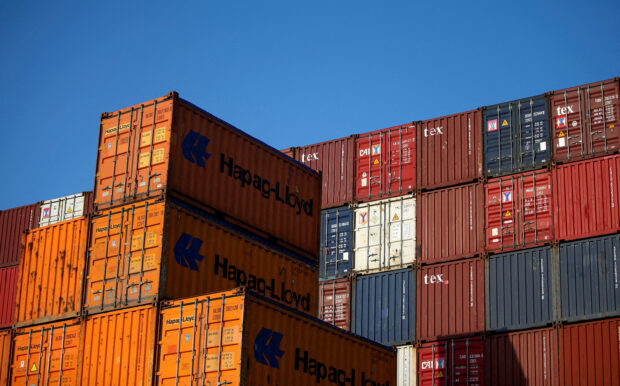European, US retailers absorb Red Sea shock, wary of hiking prices

Piled up containers at the harbour in Hamburg, Germany, July 19, 2022. REUTERS/Cathrin Mueller/File photo
LONDON —Carrying more stock, switching to suppliers nearer to consumers and reducing dependence on China are tactics European and U.S. retailers used to build more resilient supply chains following disruptions during the COVID-19 pandemic.
Faced now with transport delays of two weeks or more as cargo ships are rerouted from the Red Sea, they have limited financial wiggle room to splurge on workarounds like air freight that would get products into stores faster.
A surge in inflation since the pandemic has also caused shoppers around the world to cut back on spending, putting retailers’ focus squarely back on reducing their costs, industry experts said. Many are simply opting to take the hit from higher transport costs rather than risk hiking prices.
The rapid growth of China-founded e-commerce companies like Shein and Temu that deliver huge amounts of low-priced clothes and accessories from China to Europe and the United States by air has also increased the pressure on competing retailers to make their supply chains as lean as possible.
READ: Chinese shopping app Temu wows US amid TikTok fears
“If supply chain resilience means paying more for your goods, then that isn’t going to wash,” said Matt Clark, who leads the EMEA retail practice at consultancy AlixPartners in London.
Retailers’ “need to drive profitability is trumping the intent around supply chain resilience”, he added.
Spiraling costs
Some fashion retailers are working around the Red Sea by using sea-air freight, which involves shipping products to Dubai and then flying them from there, but they are being highly selective.
Air freighting goods is around 10 to 12 times more expensive than shipping by sea, according to Sunandan Ray, CEO of U.S.-based Unique Logistics. For budget fashion retailer Primark, air freight would not be economical, the finance director at parent company Associated British Foods said on Tuesday.
READ: Red Sea shipping workarounds add costs, delays for suppliers, retailers
Clothing and sportswear retailers also want to avoid overstocking, having only just recovered from a glut that forced them to sell products at a discount.
Sports equipment and apparel wholesaler Intersport Deutschland has stocked up over the past weeks to manage the expected two-week delays caused by ships rerouting from the Red Sea, Chief Financial Officer Thomas Storck said in an interview.
But overall, the company’s inventory level is significantly lower than a year ago, he said. That’s a result of warehouse investments that have improved its ability to get products to more than 1,400 independent Intersport stores in Germany faster.
Intersport Deutschland plans to absorb the higher transport costs rather than passing them on to store owners or consumers through higher prices.
Budget furniture manufacturer Inter IKEA also said that for now, its pricing planning remains unchanged despite the Red Sea disruption.
“We remain committed to our work to strengthen the affordability of IKEA products,” the company said in a statement.
Focus on ‘nearshoring’
One way retailers are trying to account for the cost increase and avoid running out of stock is by doing less discounting than is usual for this time of year.
READ: Ocean cargo rates climb after new Red Sea ship attacks
In the United States, retailers’ discounts have averaged 39 percent so far in January, down from 41 percent a year ago according to data from LSEG and Centric Market Intelligence.
The disruptions to shipments from Asia to Europe and the United States may spur more retailers to “nearshore” or source more from suppliers closer to their markets, but here too, cost is a key consideration.
Swedish fashion retailer H&M said it is “increasing the share of nearshoring to be closer to the customer”, without giving a specific target.
Intersport Deutschland also aims to “nearshore”, said Storck, but “you cannot do this overnight because you also have to reflect the cost, and what the consumer is willing to pay.”
For European retailers, buying from factories in the region is typically more costly than sourcing from China and other Asian countries, making it difficult to do at scale while remaining competitive.
Sourcing from China
“China is still the biggest origin country for fashion apparel, and the quality-price ratio is so good that even if some companies want to cut back on the share that China has in their overall production, it’s almost impossible because it is so well positioned,” said Laurens Schoningh, global head of fashion logistics at Hellmann Worldwide Logistics.
Swetha Ramachandran, who manages a consumer brands portfolio at Artemis Fund Managers, said she would not welcome companies “nearshoring” if that led to higher costs.
“We obviously as investors would not want to see them sacrifice long-term profits,” said Ramachandran, whose fund invests in companies including Inditex, Nike, and Adidas.
“There is a way for companies to diversify their supply chains without necessarily sacrificing their profit margins, by offsetting the cost of nearshoring through increased efficiencies.”